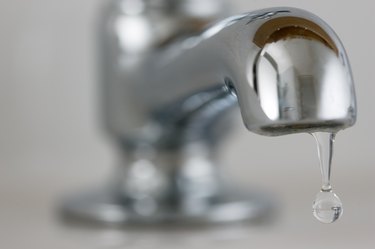Your Conclusive Manual to Dealing with Low Water Pressure in Your Home
Your Conclusive Manual to Dealing with Low Water Pressure in Your Home
Blog Article
We have uncovered this article about 10 Reasons for Low Water Pressure in Your House below on the internet and reckoned it made perfect sense to quickly share it with you here.

Low tide stress in your home can be an aggravating problem, influencing every little thing from showering to washing recipes. If you're experiencing weak water flow, there are numerous feasible reasons and options to explore. In this overview, we'll talk about common factors for low tide stress and practical steps to deal with the issue successfully.
Intro to Low Water Pressure
Low water pressure happens when the circulation of water from your taps, showers, and other fixtures is weak than usual. This can make daily jobs a lot more tough and less effective. Understanding the root causes of low water pressure is crucial to discovering the appropriate option.
Common Sources Of Low Water Stress
Pipeline Obstructions
In time, pipes can end up being blocked with natural resource, sediment, or particles, restricting the circulation of water. This is an usual issue in older homes with galvanized steel pipes.
Rust
Rust within pipes can bring about leaks and decreased water stress. Rust buildup can constrict water flow, especially in aging plumbing systems.
Faulty Stress Regulators
Stress regulatory authorities are responsible for preserving consistent water pressure in your house. If they malfunction, it can cause low tide stress or irregular flow throughout the house.
Local Water Issues
Sometimes, the trouble lies outside your home. Metropolitan water supply problems, such as main line leakages or maintenance work, can momentarily decrease water stress in your area.
Just How to Detect Low Water Stress
Examining Taps and Fixtures
Begin by testing the water pressure at various faucets and fixtures throughout your home. If the concern is isolated to certain locations, it may suggest local issues.
Examining Pipelines
Check visible pipelines for indicators of leaks, deterioration, or blockages. Take note of any uncommon audios, such as knocking or rattling pipes, which could show problems within the plumbing system.
Consulting with a Plumber
If you're unable to determine the source of low tide pressure, think about working with an expert plumber to perform a comprehensive inspection. They can identify underlying problems and suggest ideal solutions.
Do It Yourself Solutions to Take Care Of Low Tide Stress
Cleaning Up Aerators and Showerheads
Mineral deposits can gather in aerators and showerheads, minimizing water circulation. Get rid of and clean up these elements frequently to improve water pressure.
Flushing Water Heater
Sediment buildup in the water heater can restrict circulation and decrease efficiency. Flushing the container regularly assists get rid of debris and maintain optimum efficiency.
Inspecting Pressure Regulatory Authority
Make sure that the pressure regulatory authority is working properly. Adjusting or changing the regulator can aid restore proper water pressure throughout your home.
Clearing Clogs in Piping
For minor obstructions, try using a plumbing snake or chemical drain cleaner to clear blockages in pipelines. Be cautious when utilizing chemicals and adhere to safety and security standards.
When to Call a Specialist Plumber
If do it yourself initiatives fail to resolve the concern or if you presume substantial plumbing problems, it's ideal to look for help from an accredited plumber. They have the competence and tools to deal with intricate issues securely and efficiently.
Safety Nets to Keep Water Pressure
Regular Upkeep
Arrange regular maintenance for your plumbing system to prevent problems such as rust, leakages, and obstructions. Resolving small troubles early can assist prevent more considerable fixings later on.
Setting Up a Pressure Booster
Think about mounting a stress booster pump to improve water stress in areas with consistently reduced flow. This can be particularly advantageous for multi-story homes or residential properties with high-demand components.
Tracking Water Usage
Be mindful of water usage behaviors and stay clear of ill-using the plumbing system. Simple changes, such as astonishing showers and washing loads, can assist maintain ample water pressure.
Verdict
Managing low tide pressure can be discouraging, however identifying the underlying causes and applying ideal options can restore optimal circulation throughout your home. Whether it's cleaning aerators, examining pipelines, or talking to a plumber, taking positive actions can make sure a consistent supply of water for your daily needs.
How to Fix Low Water Pressure In Your Home
Municipal Water Supply Issues
Scheduled maintenance, high demand, and water main breaks are all potential causes for low water pressure within a city or county’s water lines. While there’s not much you can do to personally fix a problem with your city or county’s water supply system, you can play a big role in documenting the issue and alerting those who can.
How to fix it:
Ask your neighbors if they are experiencing any issues with low water pressure. If multiple homes are affected, it’s likely related to the city’s water line.
Contact the local Water Authority to see if there is any maintenance taking place that might be affecting your supply. Also let them know of your specific issues. If other homeowners report the same issues, they’ll know that there could be a larger issue to look into.
Faulty Fixtures
A damaged or clogged shower head, faucet or appliance is the first thing we’d suggest checking, especially if low water pressure appears to be isolated to a specific area of your home.
How to fix it:
First, turn off the main water supply to your home.
Check the affected appliances for build-up or debris. In the case of a faucet, you can simply unscrew the aerator at the tip of the faucet. Showerheads should be fully detached from the water pipe.
While the appliances are detached, you may want to check the water supply to determine if the fixtures were in fact the issue.
To clean, soak the showerhead or aerator in vinegar and brush off any visible debris.
Reattach the fixtures and check the water pressure again. If it is still low, there is likely a deeper issue at hand, which can be determined by a professional plumber.
Pipe Obstructions
Mineral deposits, rust or other debris within water pipes can lead to blockages or corrosion over time.
How to fix it:
When you think of a clog, you probably think of a drain clog. While there are many DIY solutions to clearing a drain, clogs in a water pipe will almost always require the help of a professional plumber. A plumber will be able to locate the affected pipe and clean out any debris or mineral deposit buildup. In severe cases, the pipe may need to be replaced. Your plumber might also recommend a water softening system to remove the minerals from your home’s water supply that can contribute to pipe blockages over time.
Plumbing Leak
Undetected water line leaks can divert water away from your residential pipes, reducing the water pressure in your fixtures.
How to fix it:
Check your water meter by turning off all water sources and monitoring the meter for any movement, which could be a clear indicator of a potential leak.
Check all visible pipes for signs of leaking, including water stains, active dripping or damp spots around the pipe.
Inspect fixtures, including faucets and showerheads, for any drips.
Test the pressure but recording the pressure with the main water valve shut off. Leave off for a few hours and test again. A significant drop in pressure is a clear sign of a leak.
https://kiddcoplumbing.com/plumbing-blog/how-to-fix-low-water-pressure/

How to Fix Low Water Pressure In Your Home
Municipal Water Supply Issues
Scheduled maintenance, high demand, and water main breaks are all potential causes for low water pressure within a city or county’s water lines. While there’s not much you can do to personally fix a problem with your city or county’s water supply system, you can play a big role in documenting the issue and alerting those who can.
How to fix it:
Faulty Fixtures
A damaged or clogged shower head, faucet or appliance is the first thing we’d suggest checking, especially if low water pressure appears to be isolated to a specific area of your home.
How to fix it:
Pipe Obstructions
Mineral deposits, rust or other debris within water pipes can lead to blockages or corrosion over time.
How to fix it:
When you think of a clog, you probably think of a drain clog. While there are many DIY solutions to clearing a drain, clogs in a water pipe will almost always require the help of a professional plumber. A plumber will be able to locate the affected pipe and clean out any debris or mineral deposit buildup. In severe cases, the pipe may need to be replaced. Your plumber might also recommend a water softening system to remove the minerals from your home’s water supply that can contribute to pipe blockages over time.
Plumbing Leak
Undetected water line leaks can divert water away from your residential pipes, reducing the water pressure in your fixtures.
How to fix it:
https://kiddcoplumbing.com/plumbing-blog/how-to-fix-low-water-pressure/
I came across that blog entry about 9 Reasons for Low Water Pressure in Your House while looking around the web. Sharing is good. One never knows, you may be doing someone a favor. Thanks a lot for your time spent reading it.
Article Report this page